The beauty of our solar system(pics) / La belleza de nuestro sistema solar(fotos)
¡Hola steemians! Como estoy escribiendo una historia de ciencia ficción, me metí al JPL de la NASA para ver un par de imagenes inspiradoras, y la verdad que me inspiré tanto que quiero compartir con ustedes la belleza de nuestro sistema solar. Acá van alguna de las mejores fotos:
¡Hello Steemians! Since I´m writing a science fiction story, I got into NASA´s JPL website to inspire myself looking at some pictures, and I got so inspired that I decided to share with you the beauty of our solar system. Here are some of the best pics:
Mercurio/Mercury:
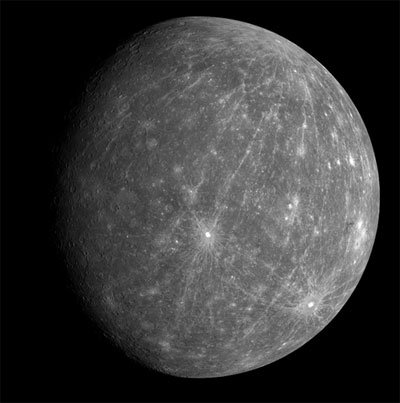
Mercurio es el más chico de todos los planetas en nuestro sistema solar y el que está más cerca del sol. Su año solar dura solo 88 dias y su temperatura va de -173° C hasta 427° C. Definitivamente no estaríamos cómodos ni al sol ni a la sombra. :P Dato impresionante: Mercurio se mueve alrededor del sol a una velocidad de 110.000 kilometros por hora.
Mercury is the smallest of all the planets in our solar system, and the one who is closest to the sun. Its solar year lasts only 88 days and its temperature goes from a chilly -173° C to a scorching 427° C. Impressive fact: Mercury moves around the sun at a speed of 110,000 kilometers per hour.

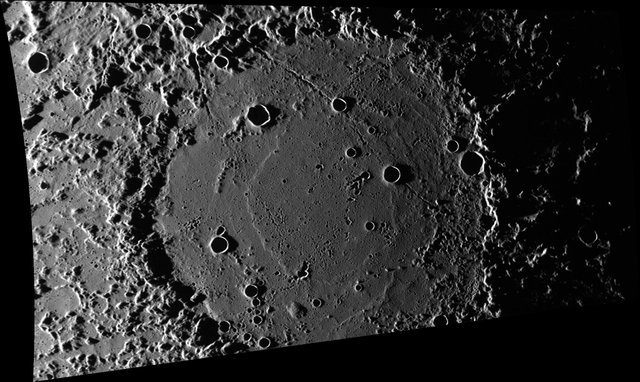
Venus/Venus:



Tierra/Earth:

La conocemos, la amamos, pero nuestro amor tóxico la está matando lentamente. Ya dije suficiente sobre nuestro planeta más conocido.
We know her, we love her, but our toxic love is killing her slowly. Enough said about our most known planet.

Marte/Mars:

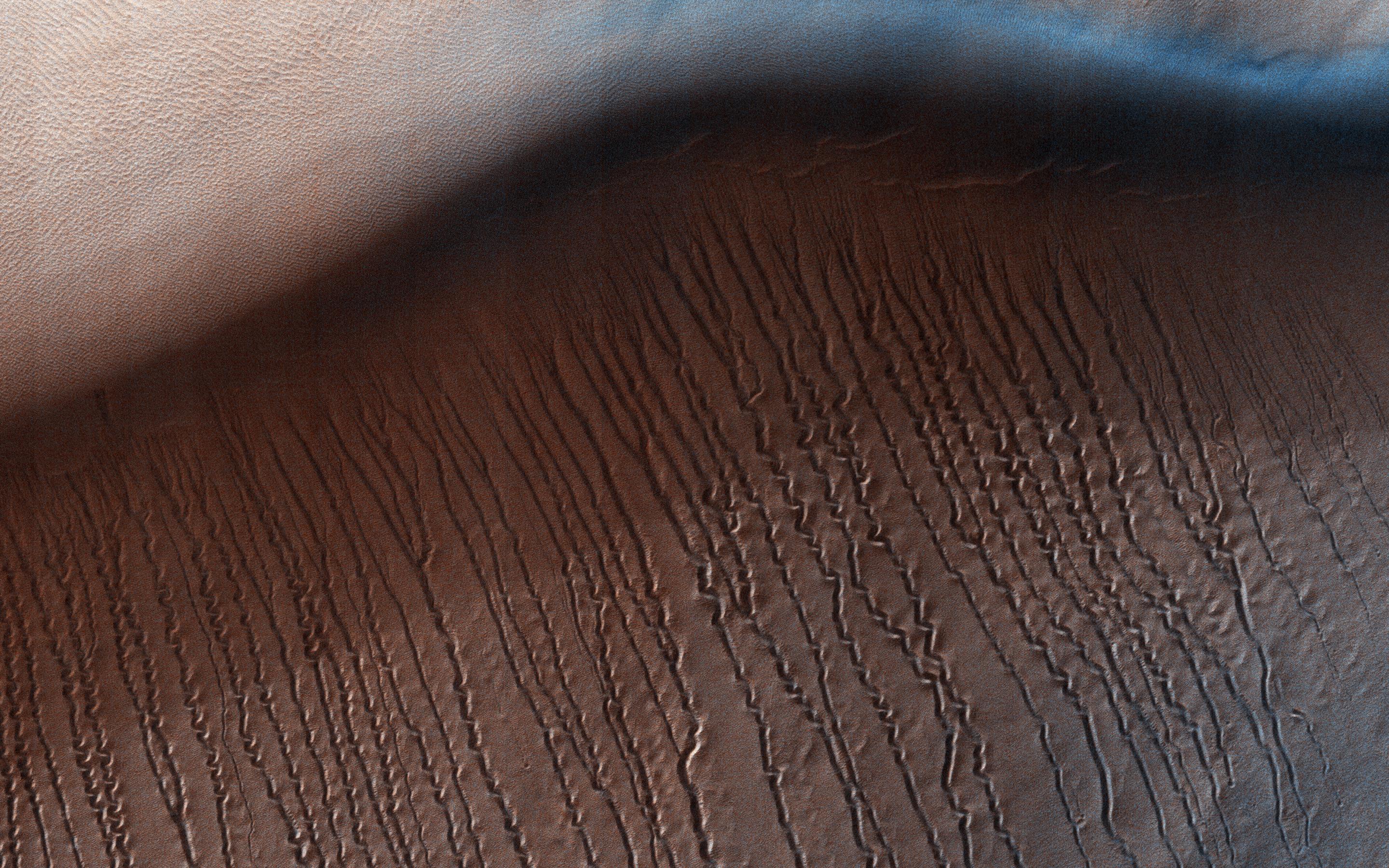
Marte es el cuarto planeta desde el sol y es el segundo más chico del sistema solar. Debe su nombre al dios romano de la Guerra. Marte es a menudo descrito como el "planeta rojo" por su apariencia rojiza. Marte es un planeta terrestre con una delgada atmósfera compuesta primariamente de dioxido de carbono.
Mars is the fourth planet from the Sun and is the second smallest planet in the solar system. Named after the Roman god of war, Mars is also often described as the “Red Planet” due to its reddish appearance. Mars is a terrestrial planet with a thin atmosphere composed primarily of carbon dioxide.

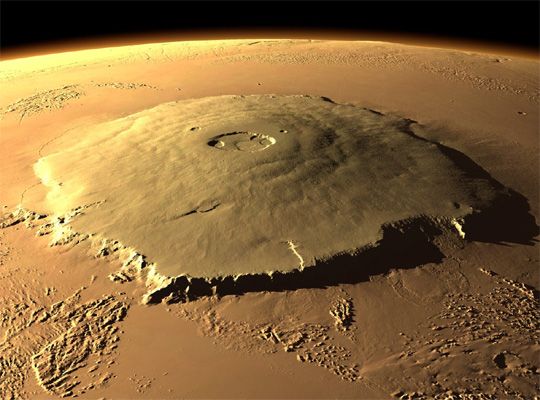
- Marte tiene la montaña más alta de todo el sistema solar: El monte Olimpo, ¡es un volcán(posiblemente activo) de 21 kilometros de altura!
- Hay señales de agua liquida en Marte: Por años se supo que marte tenía agua en forma de hielo. Los primeras señales de agua liquida son franjas oscuras o manchas en las paredes de los crateres y cañones vistas desde los satelites. Por la atmosfera de marte esta agua tiene que ser salada para prevenir el congelamiento o la evaporación.
- Mars is home to the tallest mountain in the solar system: Mount Olympus, it is a 21 km high possibly active volcano!
- There are signs of liquid water on Mars: For years Mars has been known to have water in the form of ice. The first signs of trickling water are dark stripes or stains on crater wall and cliffs seen in satellite images. Due to Mars’ atmosphere this water would have to be salty to prevent it from freezing or vaporising.
Fobos/Phobos:
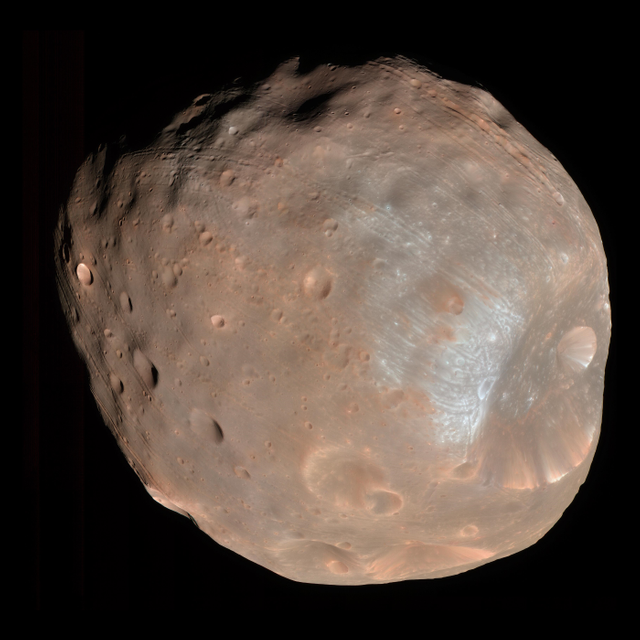
Fobos es una de las dos lunas de Marte. Es la más grande de las dos, y está plagada de crateres y parece tener surcos y rayas de material en sus bordes.
- La orbita de Fobos es tan rápida que un observador en el planeta la vería salir en el oeste y esconderse en el este dos veces por cada día marciano.
- Al menos una misión humana a marte ha sido sugerida, usando Fobos como un área de ensamblado de misiones que más tarde irian al suelo marciano.
- Tan solo tiene un diámetro de 22km. Se ve como un punto en el cielo marciano.
Phobos is one of the two moons of Mars. It is the larger of the two moons, and is heavily cratered and appears to have grooves and streaks of material along its sides.
- Phobos’s orbit is so fast it would appear to an observer on the planet to rise in the west and set in the East twice each Martian day.
- At least one human mission to Phobos has been suggested, using Phobos as a staging area for missions that would later go to Mars’ surface.
- It has only a 22 km diameter. It is only a dot on the martian sky.
Deimos/Deimos:
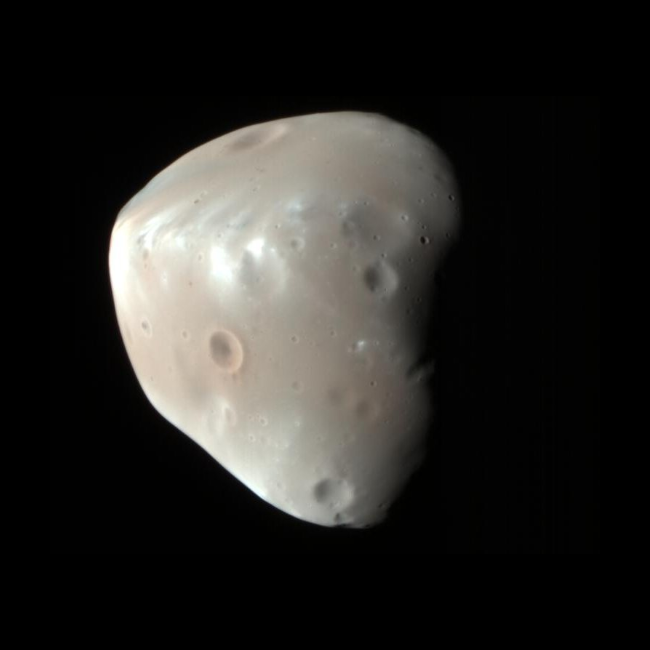
- Es la más pequeña de las dos lunas con tan solo 12,4 km de diametro.
- Ni Fobos ni Deimos tienen atmosferas, no tienen gases como para crear una y su gravedad no alcanza para retenerla.
- Se cree que tanto Fobos como Deimos son en realidad asteroides tipo C capturados por la gravedad de marte en una orbita estable.
-Its the smalles of the two moons with a diameter of only 12.4 km.
-Neither Phobos nor Deimos have atmospheres, they dont have gases to create one and their gravity is not enough to retain one.
-It is believe that both Phobos and Deimos are in reality type C asteroids captured by mars gravity into a stable orbit.
El cinturón de asteroides/The Asteroid Belt:
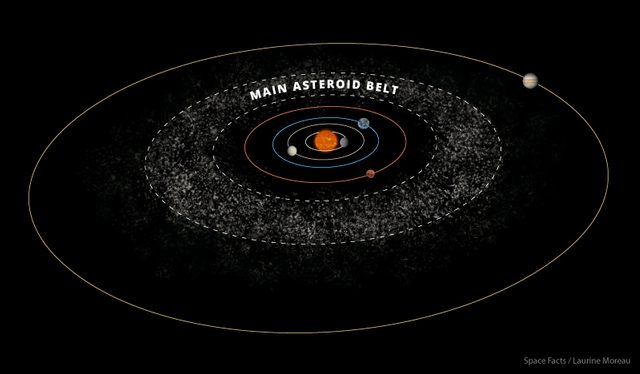
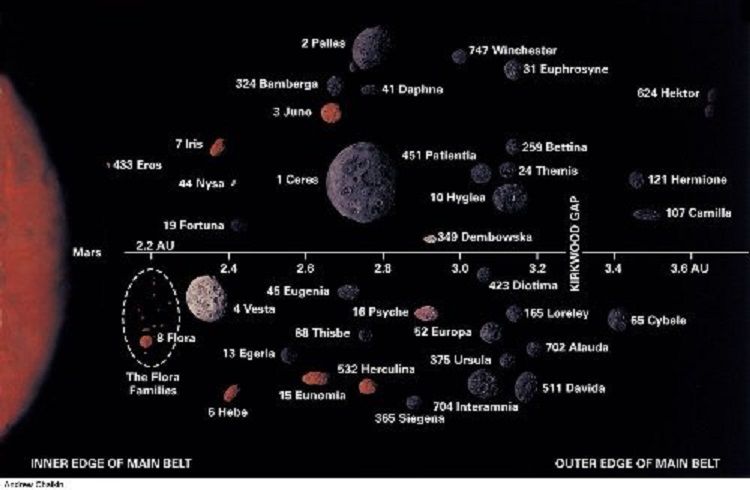
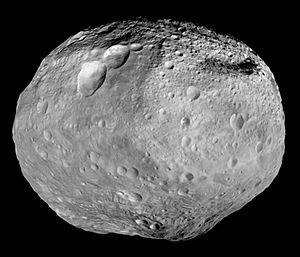
El cinturón de asteroides es una zona entre Marte y Júpiter, donde se concentran gran cantidad de ellos. Los asteroides más grandes en el cinturón son Ceres, Vesta, Pallas y Hygiea, y entre ellos contienen la mitad de la masa del cinturón de asteroides. El sistema solar tiene muchos tipos distintos de asteroides, agrupados por el tipo de minerales que poseen. Contienen abundancia de metales como el niquel, hierro y titanio(solo para nombrar unos pocos), y algunos contienen agua. Esos asteroides son un objetivo atractivo para establecer mineria espacial en el futuro cercano y varias compañías ya se encuentran interesadas.
- Los objetos del cinturón de asteroides están compuestos de piedra y roca. Algunos son objetos solidos, mientras que otros son "pilas de escombros" en orbita.
- El cinturón de asteroides contiene billones y billones de asteroides.
- El asteroide 1/Ceres también está designado como un planeta enano, el más grande en el sistema solar interior.
- El cinturón de asteroides puede contener muchos objetos, pero están desparramados por una gran área del espacio, y esto le permitió a las naves espaciales moverse por esta región sin golpear nada.
The Asteroid Belt is a zone between Jupiter and Mars, where a great quantity of them are concentrated. The biggest asteroids in the belt are Ceres, Vesta, Pallas and Hygiea, and they contain half the mass of the belt. Our solar system has many types of asteroids, and are grouped by the mineral types they posess. They contain great abundance of metals like nickel, iron, and titanium, just to name a few. Some of them even contain water. These asteroids are an attractive goal for space mining in the near future and several companies are already interested.
- Asteroid Belt objects are made of rock and stone. Some are solid objects, while others are orbiting “rubble piles”.
- The Asteroid Belt contains billions and billions of asteroids.
- The asteroid 1/Ceres is also designated as a dwarf planet, the largest one in the inner solar system.
- The Asteroid Belt may contain many objects, but they are spread out over a huge area of space. This has allowed spacecraft to move through this region without hitting anything.
Ceres/Ceres:

Ceres es el planeta enano más cercano del sol y está ubicado en el cinturón de asteroides, entre Marte y Júpiter, convirtiendolo en el único planeta enano en el sistema solar interior. Ceres es el más pequeño de los cuerpos clasificados como planetas enanos con un diámetro de 950 km.
Ceres fue el primer objeto considerado como un asteroide: El astrónomo italiano Giuseppe Piazzi lo descubrió y lo llamó Ceres en 1801.
Cada segundo Ceres pierde 6kg de su masa en vapor: descargas de vapor de agua se disparan de la superficie de ceres, y fueron observados por el telescopio espacial Herschel. Esta fue la primera observación definitiva de vapor de agua en el cinturón de asteroides.
Ceres es el único planeta enano sin lunas: Los otros planetas enanos; Plutón, Haumea, Makemake y Eris tienen por lo menos una luna.
Ceres is the closest dwarf planet to the Sun and is located in the asteroid belt, between Mars and Jupiter, making it the only dwarf planet in the inner solar system. Ceres is the smallest of the bodies current classified as dwarf planets with a diameter of 950km.
Interesting Facts:
- Ceres was the first object considered to be an asteroid: Italian astronomer Giuseppe Piazzi discovered and named Ceres in early 1801.
- Every second Ceres loses 6kg of its mass in steam: Plumes of water vapour shooting up from Ceres’ surface were observed by the Herschel Space Telescope this was the first definitive observation of water vapour in the asteroid belt. It’s thought this is caused when portions of Ceres’ icy surface warm.
- Ceres is the only dwarf planet with no moons: The other dwarf planets; Pluto, Haumea, Makemake and Eris all have at least one moon.
Júpiter/Jupiter:
El Planeta Júpiter es el 5to desde el sol, y es dos veces y media más masivo que todos los demás planetas en el sistema solar combinados. Está compuesto primariamente por gases y de ahi la clasificación de "gigante gaseoso".
Datos Interesantes:
-Júpiter tiene el día mas corto de todos los planetas: Gira una vez sobre su eje cada 9 horas y 55 minutos. La rotación es tán rápida que achata ligeramente al planeta, dandole una forma oblongada.
-Júpiter tiene características nubosas únicas: La atmosfera superior de Jupiter está dividida en cinturones de nubes y zonas. Estan principalmente compuestas por cristales de amoniaco y azufre, y una mezcla de los dos compuestos.
-La gran mancha roja es una tormenta gigante en Júpiter: Ha estado activa por más de 350 años, y es tan grande que 3 planetas tierra caberían en ella.
-El interior de Júpiter está compuesto por roca, metal, y compuestos de hidrógeno: Debajo de la atmósfera masiva de Jupiter(compuesta primariamente por hidrógeno), hay capas de gas comprimido de hidrógeno, hidrógeno metálico liquido, un nucleo de hielo, piedra y metales.
-Tiene nada menos que 67 lunas: ¡Imaginense ese cielo nocturno!
-El diametro ecuatorial de Júpiter es de 142,984 km, ¡eso significa que tendrían que viajar 285. 968 km para dar una vuelta alrededor del planeta!
The planet Jupiter is the fifth planet out from the Sun, and is two and a half times more massive than all the other planets in the solar system combined. It is made primarily of gases and is therefore known as a “gas giant”.
Interesting Facts:
-Jupiter has the shortest day of all the planets: It turns on its axis once every 9 hours and 55 minutes. The rapid rotation flattens the planet slightly, giving it an oblate shape.
-Jupiter has unique cloud features: The upper atmosphere of Jupiter is divided into cloud belts and zones. They are made primarily of ammonia crystals, sulfur, and mixtures of the two compounds.
-The Great Red Spot is a huge storm on Jupiter: It has raged for at least 350 years. It is so large that three Earths could fit inside it.
-Jupiter’s interior is made of rock, metal, and hydrogen compounds: Below Jupiter’s massive atmosphere (which is made primarily of hydrogen), there are layers of compressed hydrogen gas, liquid metallic hydrogen, and a core of ice, rock, and metals.
-It has 67 moons: Imagine that night sky!
-Jupiter´s Equatorial Diameter is 142,984 km, meaning you would have to travel 285, 968 km to go around the planet!.

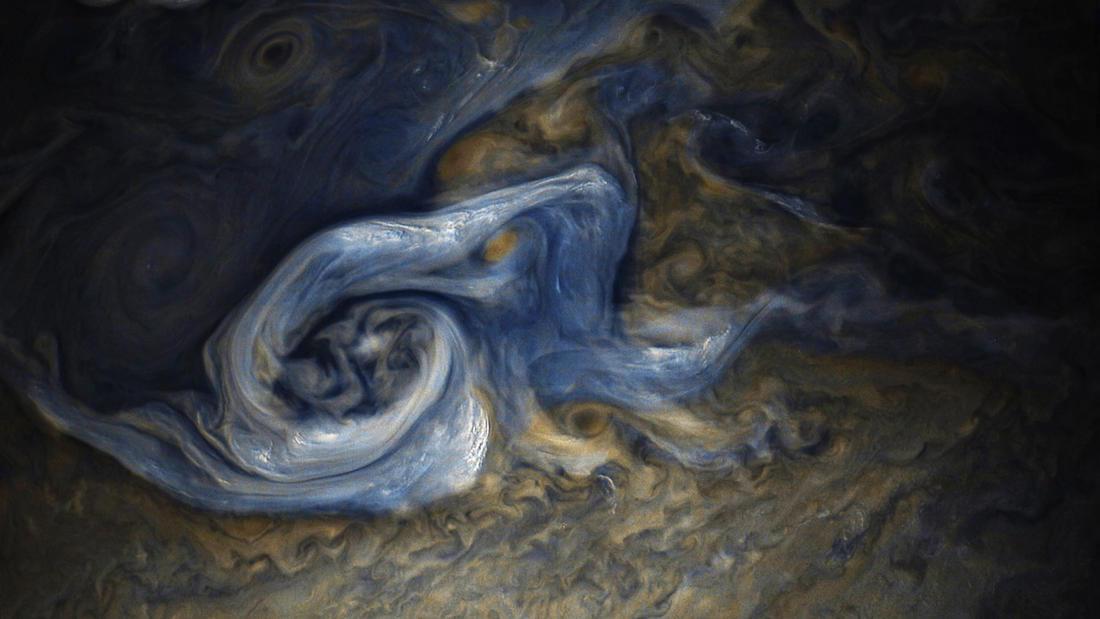
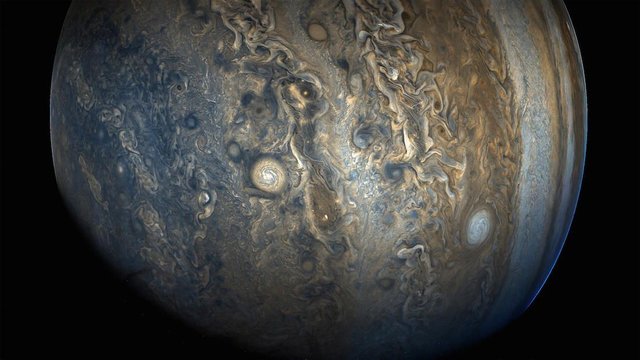
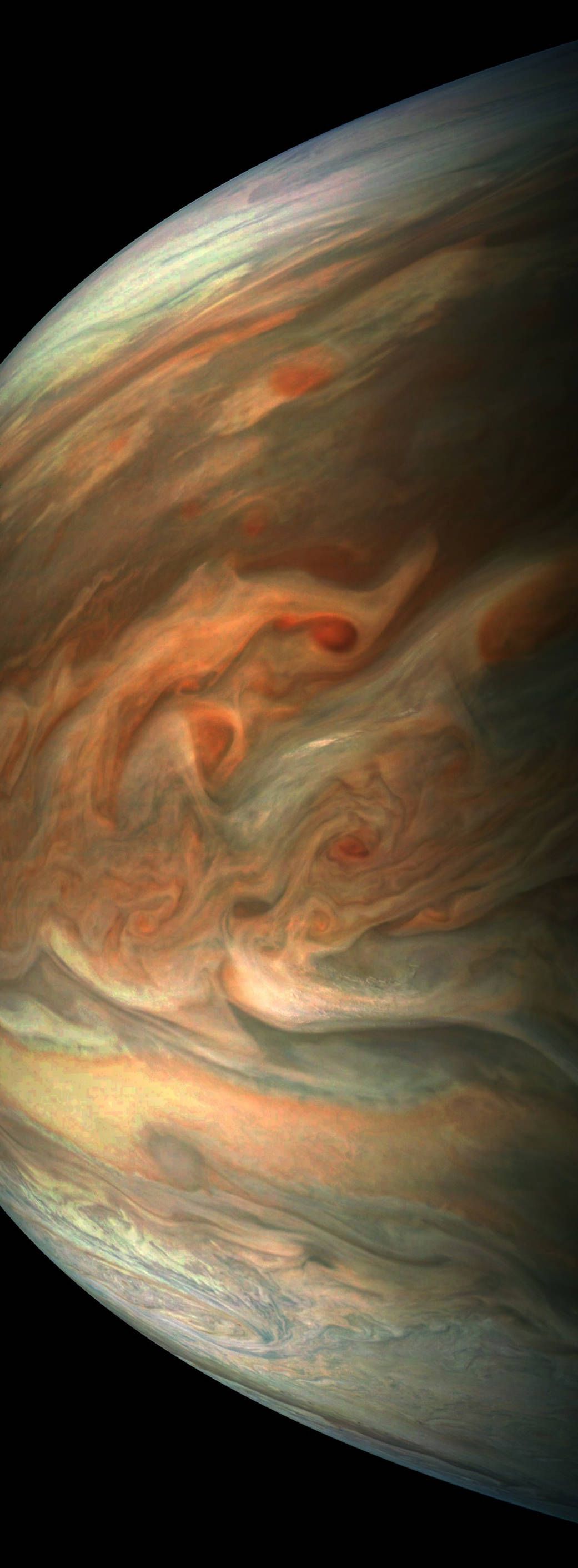
Io/Io:

Io es la luna más cercana a Júpiter, descubierta por Galileo Galilei.
- Tiene más de 400 volcanes activos, convirtiendola en el cuerpo más volcanicamente activo en todo el sistema solar.
- El volcanismo de Io se debe a que Jupiter la estira constantemente con su fuerte empuje gravitacional.
- Las descargas volcanicas de Io se elevan hasta 200km, duchando el terreno con dioxido sulfurico.
- No va a haber misiones humanas en Io durante un largo tiempo, debido a su ambiente de radiación extrema y atmosfera y superficie altamente tóxicas.
Io is the moon closest to Jupiter, discovered by Galileo Galilei.
- It has over 400 active volcanoes, making it the most active volcanic body in the whole solar system.
- Volcanism is due to constant tidal stretching by jupiter´s gravity.
- The volcanic plumes rise up to 200km, showering the terrain with sulfur dioxide.
- There wont be manned missions to it anytime soon, due to its extreme radiaton environment and toxic atmosphere and surface.
Europa/Europa:

- Europa es una luna de Júpiter aproximadamente del mismo tamaño que nuestra luna en la Tierra.
- Si bien la superficie de Europa está congelada, todo el interior del planeta está compuesto por un océano de agua liquida. Gracias a la fricción gravitatoria con Júpiter, el océano en su interior está mucho más caliente que su superficie, lo que lleva a la hipotesis de que puede contener vida. Los cientificos encontraron indicios de que este océano estaría principalmente compuesto por agua salada.
- Claramente Europa tendría mucha más agua liquida que todos los océanos de nuestra tierra combinados.
-Europa is a Jupiter moon approximately the same size of our own moon.
-Even though the moon´s surface is frozen, the interior of the planet is made of an ocean of liquid water. Thanks to the gravitatory friction with Jupiter, the liquid ocean beneath the surface is much warmer than the icy exterior, which leads to the hypothesis that it may contain life. Scientists encountered clues that this ocean would be composed mainly of salty water.
-Clearly Europa would have many more times liquid water than all of our world´s oceans combined.
Ganimedes/Ganymede:
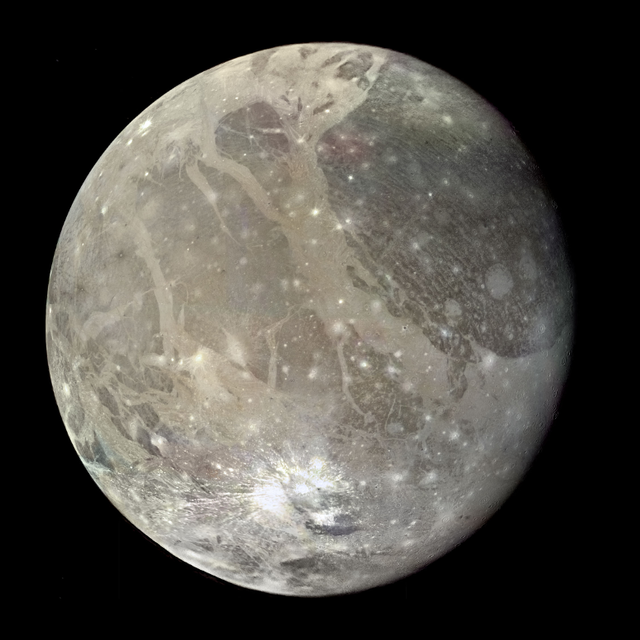
- Ganimedes es la luna más grande de Júpiter, y también la luna más grande en todo el sistema solar. Es todavía más grande que el planeta Mercurio. Si no fuera por su órbita como la luna más grande de Jupiter, sería considerado como un planeta enano.
- Ganimedes tiene una magnetosfera fuerte, similar a la de un planeta.
- Como Europa, se cree que Ganimedes tiene un océano de agua liquida en su interior, y tiene una delgada atmosfera que también contiene oxigeno. El hielo en la superficie es descompuesto en hidrogeno y oxigeno por la radiación solar.
- Ganymede is Jupiter´s largest moon and also the largest moon in our solar system. It is even larger than the planet Mercury. If it was not orbiting as Jupiter´s largest moon, it could be considered a dwarf planet.
- Ganymede has a strong magnetosphere, similar to a planet.
- Like Europa, Ganymede is thought to have a subsurface ocean, and has a thin atmosphere that also contains oxygen. The water ice on the surface is likely broken into hydrogen and oxygen by solar radiation.
Calisto/Callisto:
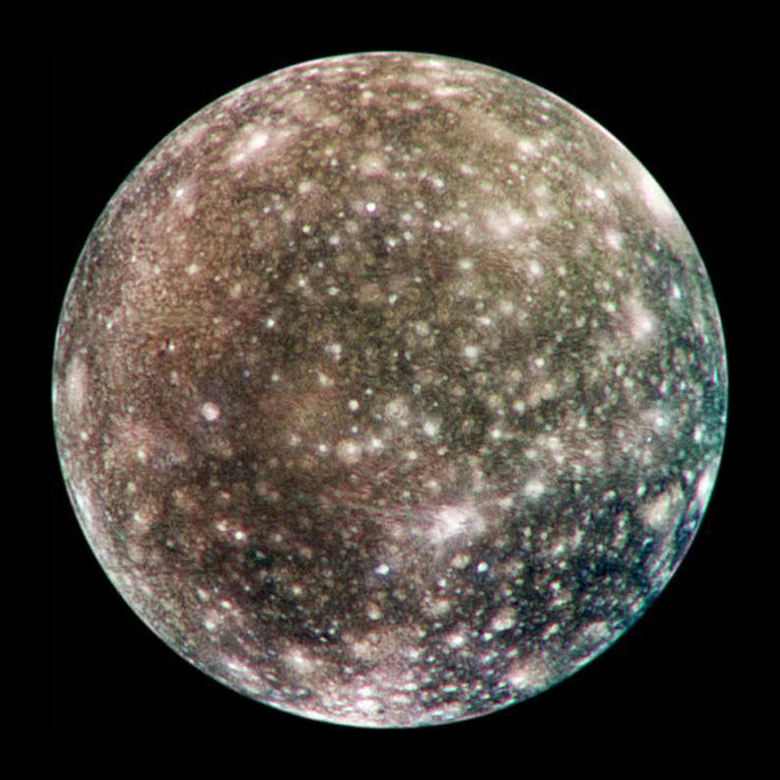
- Calisto es la segunda luna más grande en el sistema de Júpiter, y es aproximadamente del tamaño de Mercurio.
- Es mitad rocosa y mitad helada. Su superficie contiene hielo de agua, hielo de dioxido de carbono, polvo de silicato, particulas de roca e hidrocarburos compuestos.
- Calisto tiene la superficie con más crateres de todo el sistema solar. Hay tantos cráteres que un nuevo asteroide impactante destruiria un viejo crater por seguro.
- Tiene una delgada atmosfera de dioxido de carbono que fue detectada por la nave Galileo.
- Esta marcada como un posible lugar donde la NASA puede asentar una base en el 2040 para explorar más a fondo las lunas de Júpiter.
- Callisto is the second largest moon in the Jupiter system, and its nearly the size of Mercury.
- Its a half-rocky and half-icy world. Its surface contains water ice, carbon dioxide ice, silicate dust and rock particles, and hydrocarbon compounds.
- Callisto has the most heavily cratered surface in the solar system. There are so many craters than a new impactor would obliterate and older crater.
- It has a thin atmosphere of carbon dioxide. It was detected by the Galileo spacecraft.
- It is marked as a possible place where NASA might erect a base in 2040 to further explore jovian moons.
Saturno/Saturn:

Saturno es el sexto planeta desde el sol y el mas distante que puede ser visto a simple vista. Saturno es el segundo planeta más grande y es muy conocido por su sistema de anillos fabuloso que fue observado por primera vez en 1610 por el astronomo Galileo Galilei. Como Jupiter, Saturno es un gigante gaseoso y está compuesto por gases similares, incluyendo el hidrógeno, helio y metano.
Datos Interesantes:
- Saturno es el planeta más plano: su diametro polar es el 90% de su diametro ecuatorial, y esto significa que es casi tan ancho en los polos que en el ecuador. Esto es por su baja densidad y alta velocidad de rotacion. Saturno gira sobre su eje una vez cada 10 horas y 34 minutos, dandole el segundo dia mas corto de los planetas del sistema solar.
- Saturno tiene el sistema de anillos mas extensivo del sistema solar: Los anillos saturninos están hechos primariamente de trozos de hielo y pequeñas cantidades de polvo carbonico. Los anillos se extienden por mas de 120.700 km desde el planeta, pero son sorpendentemente finos: solo tienen 20 metros de grosor.
- Los anillos de saturnos están hechos de billones de particulas que varian en tamaño desde granos de polvo hasta objetos grandes como montañas.

Saturn is the sixth planet from the Sun and the most distant that can be seen with the naked eye. Saturn is the second largest planet and is best known for its fabulous ring system that was first observed in 1610 by the astronomer Galileo Galilei. Like Jupiter, Saturn is a gas giant and is composed of similar gasses including hydrogen, helium and methane.
Interesting Facts:
- Saturn is the flattest planet: Its polar diameter is 90% of its equatorial diameter, meaning its almost as wide at the poles than at the equator. This is due to its low density and fast rotation. Saturn turns on its axis once every 10 hours and 34 minutes giving it the second-shortest day of any of the solar system’s planets.
- Saturn has the most extensive rings in the solar system: The Saturnian rings are made mostly of chunks of ice and small amounts of carbonaceous dust. The rings stretch out more than 120,700 km from the planet, but are are amazingly thin: only about 20 meters thick.
- Saturn’s rings are made up of are billions of particles that range in size from tiny dust grains to to objects as large as mountains.
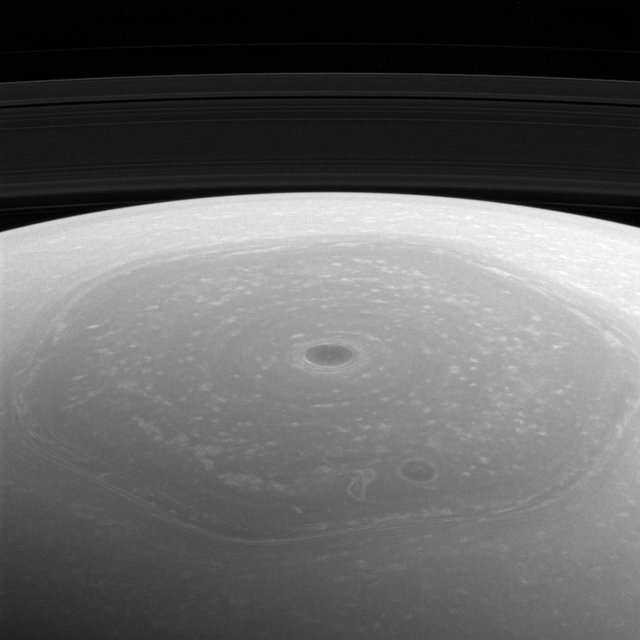
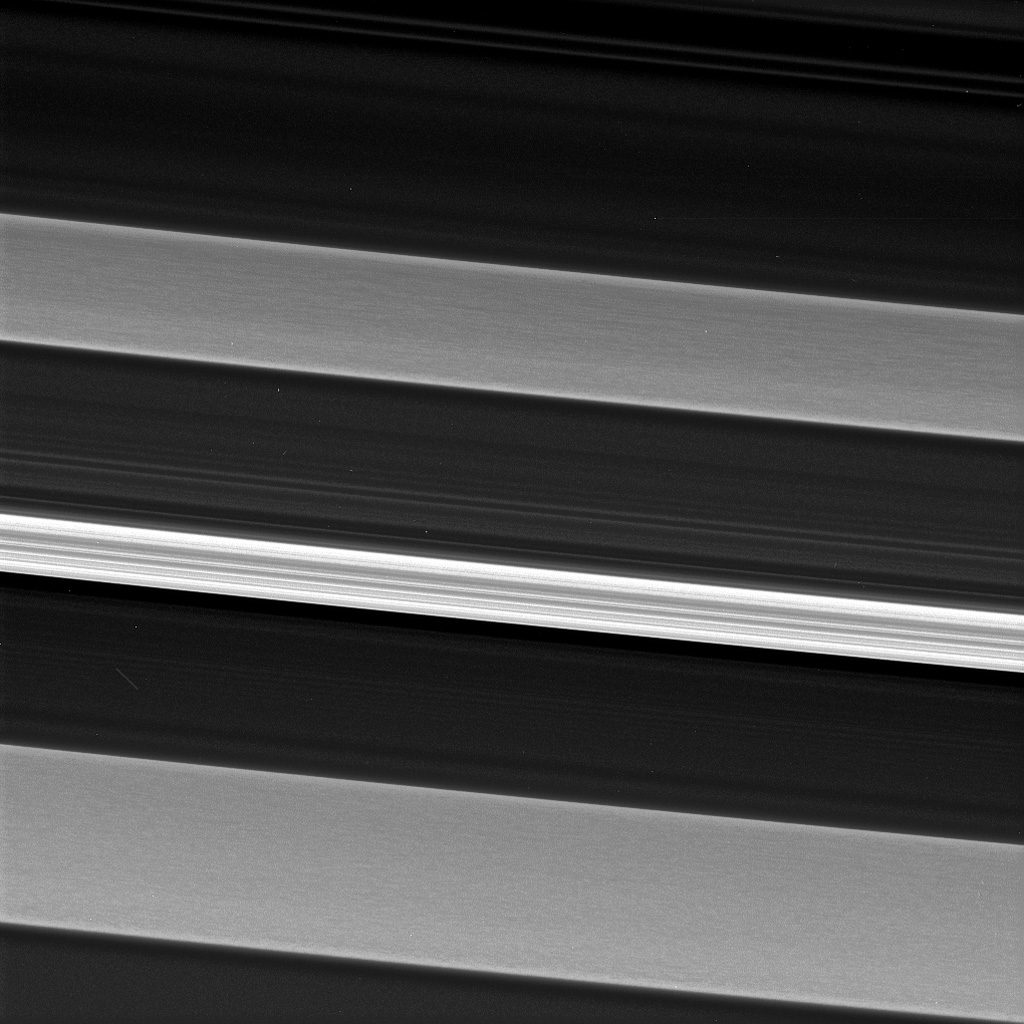
Titan/Titan:
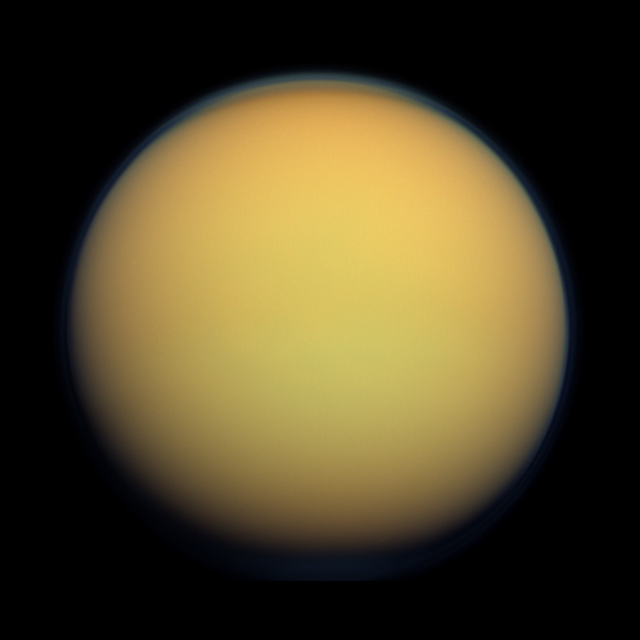
Titan es la luna más grande de Saturno y es la segunda luna más grande de todo el sistema solar. Si no estuviera orbitando saturno, sería considerado un planeta más grande que Mercurio.
- Titan tiene una densa atmosfera, parecida a la de la tierra en épocas tempranas. El gas mas abundante es el nitrogeno, con nubes de methano y etano y un denso humo organico.
- Se sabe que tiene hielo de agua por sobre un interior rocoso, y que su superficie tiene lagos de hidrocarburos.
Titan is Saturn´s biggest moon and the second biggest moon in the whole solar system. If it was not orbiting saturn, it would be considered a planet larger than Mercury.
- Titan has a dense atmosphere, similar to an early earth. The most abundant gas is nitrogen, with methane and ethane clouds and a dense organic smog.
- It is known to have water ice over a rocky interior, and its surface has hidrocarbon lakes.
Urano/Uranus:

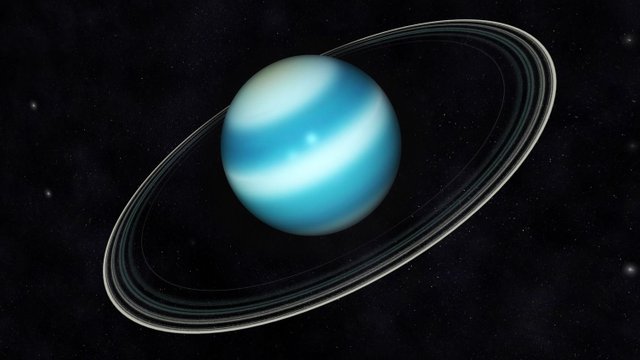
Urano es el septimo planeta desde el sol. A pesar de que es visible a simple vista, no era reconocido como un planeta por la debilidad de su luz y su orbita lenta. Urano se convirtió en el primer planeta descubierto con el uso de un telescopio. Urano está inclinado sobre su eje 98 grados, por lo que es descrito frecuentemente como "viajando alrededor del sol sobre su costado".
Datos Interesantes:
-A menudo se refieren a urano como un "gigante de hielo": Como todos los otros gigantes gaseosos, tiene una capa superior de hidrógeno mezclado con helio, pero debajo de ella se encuentra un manto helado que rodea un centro de roca y hielo. La atmosfera superior está hecha de agua, amoníaco y cristales de hielo de metano que le dan al planeta su color azul pálido.
Urano tiene las temperaturas más bajas de todos los planetas: Con una temperatura atmosferica minima de -224° C.
Todas las lunas de Urano son mundos helados con oscuras superficies.
Uranus is the seventh planet from the Sun. While being visible to the naked eye, it was not recognised as a planet due to its dimness and slow orbit. Uranus became the first planet discovered with the use of a telescope. Uranus is tipped over on its side with an axial tilt of 98 degrees. It is often described as “rolling around the Sun on its side.”
- Uranus is often referred to as an “ice giant” planet: Like the other gas giants, it has a hydrogen upper layer, which has helium mixed in. Below that is an icy “mantle, which surrounds a rock and ice core. The upper atmosphere is made of water, ammonia and the methane ice crystals that give the planet its pale blue colour.
- Uranus hits the coldest temperatures of any planet: With minimum atmospheric temperature of -224°C Uranus is nearly coldest planet in the solar system.
- All of Uranus´ moons are frozen worlds with dark surfaces.
Neptuno/Neptune:

Neptuno es el octavo planeta desde el sol y es el más distante del sistema solar.(Recuerden, Plutón ya no es un planeta). El gigante gaseoso probablemente se haya formado mucho mas cerca del sol antes de migrar a su actual posición.
Neptuno no era conocido para los antiguos: no es visible a simple vista y fue observado por primera vez en 1846. Su posición fue determinada usando predicciones matematicas. Fue nombrado así por el dios romano del mar.
La atmosfera de Neptuno está conformada de hidrógeno, helio y algo de metano. El metano absorbe la luz roja, lo que hace aparecer al planeta en un azul encantador. Nubes altas y finas vagan por su atmosfera superior.
Neptuno tiene un clima muy activo: Grandes tormentas circulan por su atmosfera superior, y vientos de alta velocidad van por el planeta a 600 metros por segundo. Una de las tormentas más grandes jamás vistas fue registrada en 1989. Fue nombrada como "La Gran Mancha Oscura", y duró por 5 años.
Neptune is the eighth planet from the Sun making it the most distant in the solar system. This gas giant planet may have formed much closer to the Sun in early solar system history before migrating to its present position.
- Neptune was not known to the ancients: It is not visible to the naked eye and was first observed in 1846. Its position was determined using mathematical predictions. It was named after the Roman god of the sea.
- The atmosphere of Neptune is made of hydrogen and helium, with some methane.
The methane absorbs red light, which makes the planet appear a lovely blue. High, thin clouds drift in the upper atmosphere.
- Neptune has a very active climate: Large storms whirl through its upper atmosphere, and high-speed winds track around the planet at up 600 meters per second. One of the largest storms ever seen was recorded in 1989. It was called the Great Dark Spot. It lasted about five years.
Tritón/Triton:
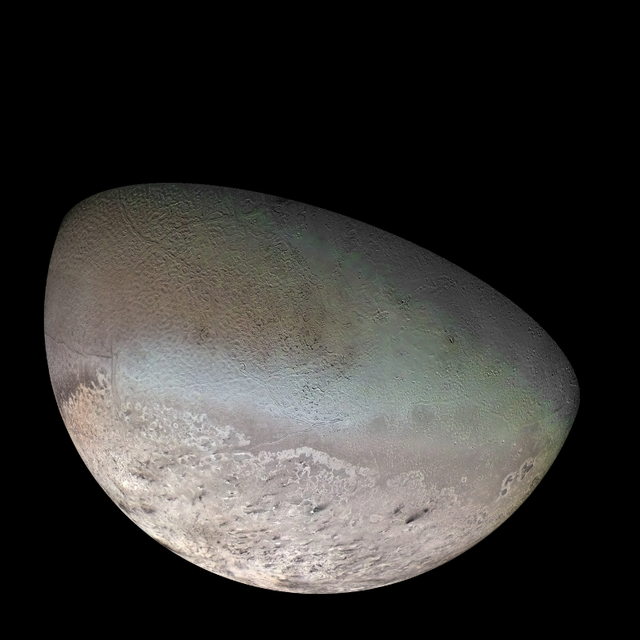
Tritón es la luna más grande de Neptuno y es la unica luna grande del sistema solar en tener una orbita contraria a la dirección de rotación de su planeta, esto es conocido como orbita retrograda.
-Tritón es un mundo congelado con una variedad bastante amplia de terrenos. Tiene crateres, géiseres y bastante terreno escabroso. Los geyseres escupen gas de nitrogeno hasta 8km de altura, como resultado, Tritón tiene una fina atmosfera de nitrogeno.
Triton is Neptune’s largest moon and is the only large moon in the solar system to orbit in the opposite direction to its planet’s rotation, this is known as a retrograde orbit.
-Triton is a frozen world with an ample variety of terrain types. It has craters, geysers, and rugged terrain. The geyser plumes go as high as 8km and spit nitrogen gas, as a result, Triton has a very thin nitrogen atmosphere.
El cinturón Kuiper/The Kuiper Belt:
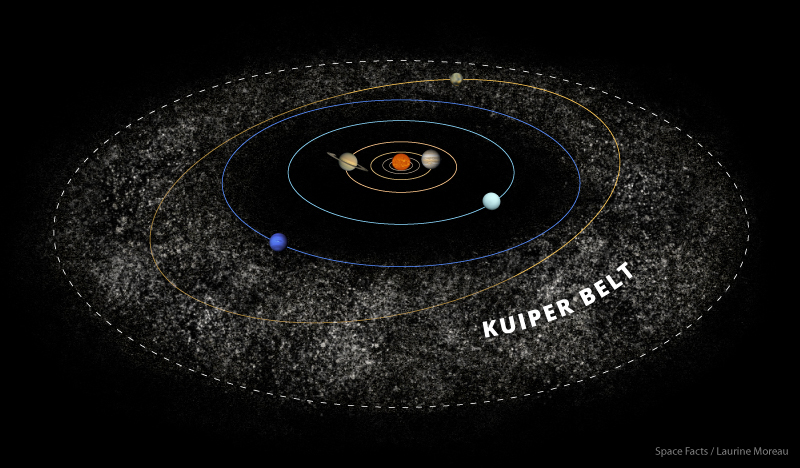
El cinturón de Kuiper es un area del sistema solar exterior que contiene un montón de pequelos asteroides. Se extiende desde aproximadamente la orbita de Neptuno y contiene cientos de miles de pequeños cuerpos helados de varias dimensiones que varian desde pequeños trozos de hielo hasta trozos de 100km de radio. Es el hogar de los planetas enanos Plutón, Haumea y Makemake.
The Kuiper Belt is an area of the outer solar system that contains a myriad of small asteroids. It extends from roughly the orbit of Neptune and contains hundreds of thousands of icy bodies that range in size from small chunks to about 100 km. It is home to the dwarf planets Pluto, Haumea and Makemake.
Plutón/Pluto:

Descubierto en 1930, Plutón es el segundo planeta enano mas cercano al sol, y hacia un tiempo era clasificado como el noveno planeta.
Plutón fue reclasificado de un planeta a un planeta enano en el 2006. No llega a ser un planeta ya que no ha limpiado la cercanía a su órbita de cuerpos extraños(por no tener el suficiente tamaño y masa).
Plutón tiene 5 lunas conocidas.
Plutón tiene 1/3 de agua: Esta está en forma de hielo, que constituye 3 veces la cantidad de agua que hay en todos los oceanos de la tierra, los dos tercios restantes son de roca. La superficie de plutón esta cubierta por hielo, tiene varias cadenas montañosas, regiones ligeras y oscuras y varios crateres.
Plutón a veces tiene una atmósfera: cuando la órbita altamente eliptica de plutón está cerca del sol, su hielo superficial se derrite y forma una atmosfera delgada, primariamente de nitrogeno que lentamente escapa el planeta. También tiene una niebla de metano que está suspendida 161 kilometros por encima de la superficie. El metano es disociado por la luz del sol en hidrocarburos que caen a la superficie y cubren el hielo con una capa oscura. Cuando Plutón se mueve lejos del sol, la atmosfera se vuelve a congelar a su estado sólido.
Discovered in 1930, Pluto is the second closest dwarf planet to the Sun and was at one point classified as the ninth planet.
- Pluto was reclassified from a planet to a dwarf planet in 2006. It is not a regular planet since it hasn´t cleared the vecinity of its orbit form foreign bodies(because it doesn´t have sufficient size and mass).
- Pluto has five known moons.
- Pluto is one third water: This is in the form of water ice which is more than 3 times as much water as in all the Earth’s oceans, the remaining two thirds are rock. Pluto’s surface is covered with ices, and has several mountain ranges, light and dark regions, and a scattering of craters.
- Pluto sometimes has an atmosphere: When Pluto elliptical orbit takes it closer to the Sun, its surface ice thaws and forms a thin atmosphere primarily of nitrogen which slowly escapes the planet. It also has a methane haze that hovers about 161 kilometres above the surface. The methane is dissociated by sunlight into hydrocarbons that fall to the surface and coat the ice with a dark covering. When Pluto travels away from the Sun the atmosphere then freezes back to its solid state.
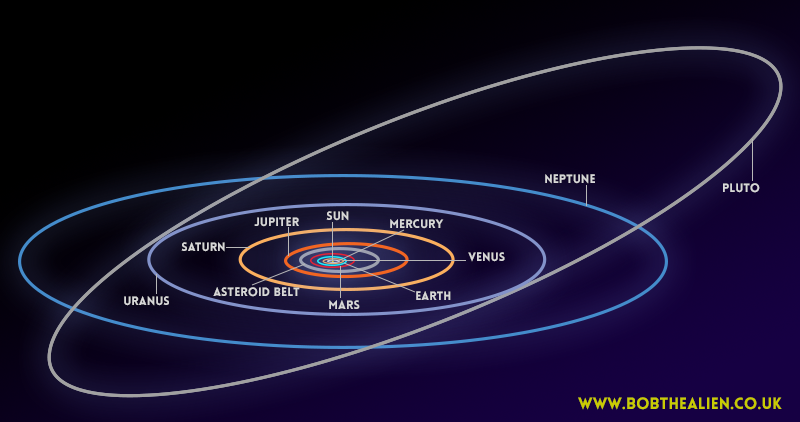
Charón/Charon:
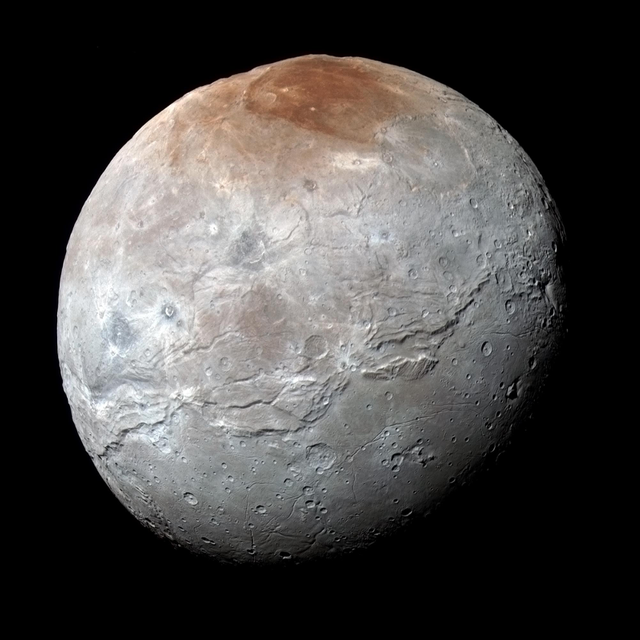
Charón es la luna más grande y de orbita más interior a Plutón. Fue descubierta en 1978 por el astronomo James Christy y tiene casi 1/8 de la masa de Plutón. Tiene un centro común de gravedad con Plutón, y los dos mundos están tidalmente bloqueados(o sea, se muestran siempre la misma cara mutuamente).
- Si no estuviera orbitando Plutón, Charón sería un planeta enano.
Charon is the largest and innermost moon of Pluto. It was discovered in 1978 by astronomer James Christy and is nearly 1/8 the mass of Pluto. It orbits a common centre of gravity with Pluto, and the two worlds are tidally locked together as they orbit.
- If it were not orbiting Pluto, Charon would be a dwarf planet in its own right.
Haumea/Haumea:
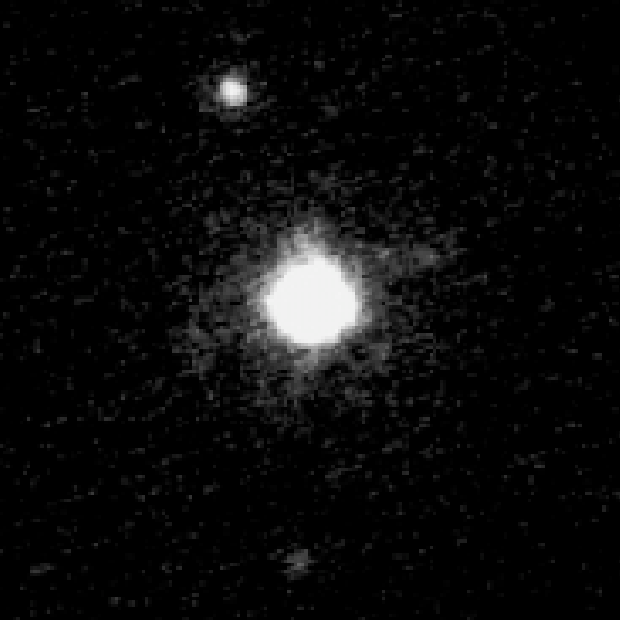
Haumea es el tercer planeta enano más cercano del sol y es unico en su forma alargada, convirtiendolo en el menos esferico de los planetas enanos.
Haumea is the third closest dwarf planet from the Sun and is unique in its elongated shape making it the least spherical of the dwarf planets.
Makemake/Makemake:
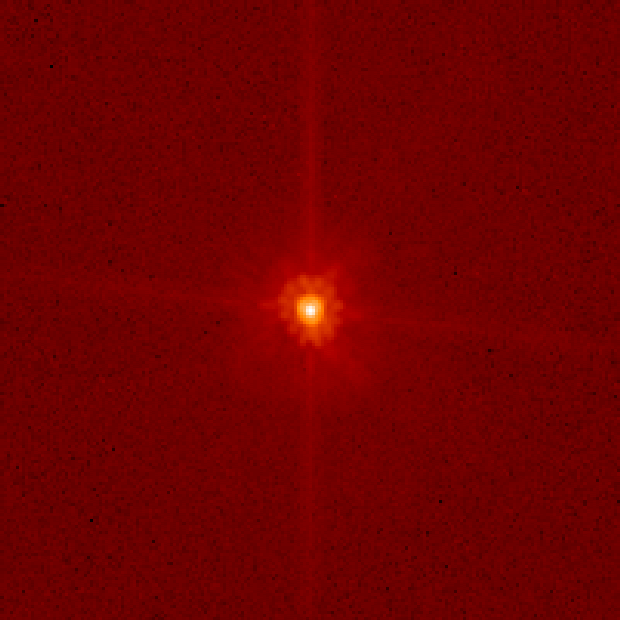
Makemake es un planeta enano de 1.434 km de diametro ecuatorial. Carece de una atmósfera y se encuentra en una orbita estable más allá de Plutón.
Makemake is a dwarf planet ranging 1,434 km in equatorial diameter. It lacks an atmosphere and it is located in a stable orbit beyond Pluto.
Eris/Eris:
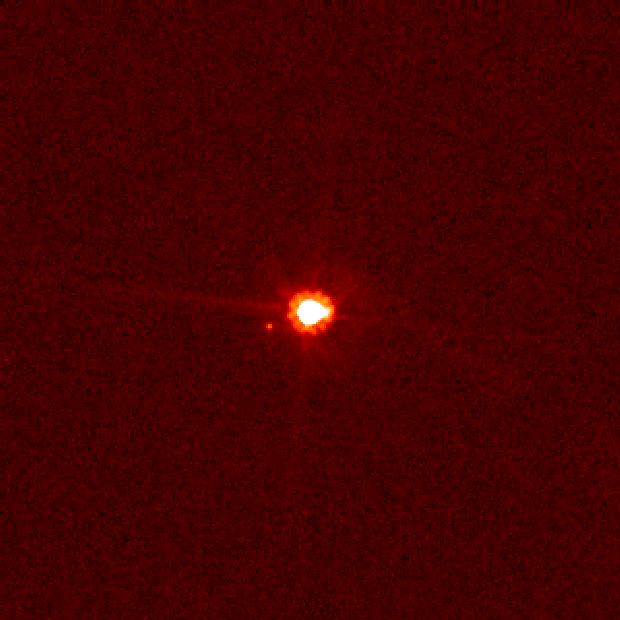
Eris es el planeta enano más lejano del sistema solar, y uno de los más grandes. De hecho tiene aproximadamente 2/3 del diametro de nuestra luna.
Eris is the outermost dwarf planet of the solar system, and it is the second biggest one. In fact, it has approximately 2/3 of the diameter of our moon.
Nube de Oort/Oort Cloud:
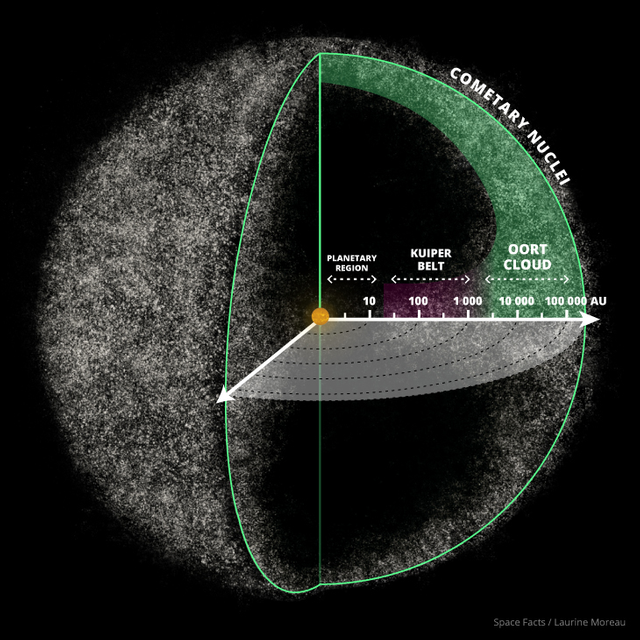
La nube de Oort es una coraza teorica de objetos congelados que se encuentra más allá del cinturón de Kuiper. Es bastante esferica y son lo que queda del disco de materiales que formaron nuestro Sol y planetas. El planetoide Sedna, descubierto en 2003 es considerado un miembro de la nube Oort Interior. Los astronomos piensan que esta es la región de donde vienen la mayoria de los cometas de largo período(los que tienen una orbita de mas de 200 años).
The oort cloud is a theorised shell of icy objects that lies beyond the Kuiper Belt. It is roughly spherical and they are remains of the disc of materials that formed our sun and planets. The planetoid Sedna, discovered in 2003 is thought to be a member of the inner Oort Cloud. Astronomers think that this is where most long period comet come from.

Fuentes de las imagenes:
https://www.nasa.gov/multimedia/imagegallery/index.html (Gracias NASA por traernos tanta majestuosidad)
https://space-facts.com
https://www.bobthealien.co.uk
Datos adicionales sobre cada planeta buscados en:
https://www.nasa.gov
https://www.wikipedia.org/
https://space-facts.com
Very well put together, and interesting!
Thanks!
Un artículo muy interesante y completo.
Si estás pensando en escribir ficción en inglés te sugiero que pases por el canal de Discord The Writer's Block.
A mi me han ayudado mucho con algunos problemas con la sintaxis.
Gracias! Por ahora, esta primera vez, va a ser en castellano, pero en el futuro seguro me animo a hacerlo en inglés!
Very long, but very interesting. Things about space amaze me. If I could, I'd live in space.
I would have a hut in Makemake. That way I could look at human stupidity from afar, specially politicians. :P
Where ever it would be, just as long as we could see what was going on here. Those would be our comedy shows.
For most, life itself is already a tragic comedy! :P
very very great post dear ... strong article up me @wolfenlord
Qué maravilla, este artículo me lo guardo.
Supongo que la novela irá del sistema solar, ¿has leído la serie de Expanse? Está muy bien la división política entre Tierra, Marte y el Cinturón. Juraría que he leído esa misma estructura en alguna otra novela, pero ahora no lo recuerdo (¿quizás el hombre incorporado?).
La novela no te voy a contar de que es porque sinó alguno capaz la escribe antes ;) . La iré posteando a medida que esté lista, no te preocupes. Y lo de la división politica de la tierra, marte y el cinturón seguro la vistes en la excelente serie de ciencia ficción "The Expanse".
http://www.imdb.com/title/tt3230854/
This post received a 4% upvote from @morwhale team thanks to @wolfenlord! For more information, click here! , TeamMorocco! .
This post has received a 10.00 % upvote from @lovejuice thanks to: @wolfenlord. They love you, so does Aggroed. Please be sure to vote for Witnesses at https://steemit.com/~witnesses.
Resteemed by @resteembot! Good Luck!
Curious?
The @resteembot's introduction post
Get more from @resteembot with the #resteembotsentme initiative
Check out the great posts I already resteemed.
This post has received a 14.93 % upvote from @kittybot thanks to: @wolfenlord.
This post has received a 7.76 % upvote from @boomerang thanks to: @wolfenlord
@boomerang distributes 100% of the SBD and up to 80% of the Curation Rewards to STEEM POWER Delegators. If you want to bid for votes or want to delegate SP please read the @boomerang whitepaper.